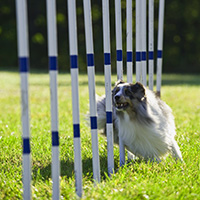Originally published in the AKC Gazette:
In my work as an agility instructor, I find that the use of quotations and sayings does two valuable things: It brings some humor to the teaching process, and it gives students key phrases to help them remember specific handling theories. Here are a few that I use.
Playing and training are synonymous.
Training should not be “work.” Work is what you do during the week so you can afford the entry fees for agility trials. Think of training as an extension of play, or as a series of interrelated tricks. Then you and your dog will have enjoyable, productive training sessions. This is not to say, of course, that your training is not hard work. I am exhausted after training my dogs. Using both your physical and mental “muscles” can be draining, but it should also be invigorating. Both you and your dog should prosper emotionally from your practice sessions.
Be proactive, not reactive.
One of the biggest differences between ineffective handlers and great handlers is the ability of the latter to predict what their dogs will do in almost any handling situation. This allows them to mentally prepare ahead of time for how the dog might respond in most agility sequences.
When you walk the course before competition, you need to do that sort of mental preparation. In some cases, you may even be able to memorize the body-language signals and verbal commands you will give your dog. Anticipating your dog’s responses allows you to be proactive as you guide her through the obstacles with well-timed commands, instead of reacting after she has made an incorrect or time-wasting move that you could have planned in advance to prevent. Create the paths you want your dog to take; do not just follow the paths she takes on her own.
Point before you shoot.
Always tell your dog where she is going before you tell her what to do. The path or direction you want your dog to take is more important than the noun (for example, tire, tunnel, seesaw and so on) that you use to command the dog to the obstacle. In other words, you need to “steer” the dog through the course with verbal commands, such as come, out, turn, go on, left and right and, most of all, with your body language. If you “point” your shoulders and feet in the direction you want the dog to travel, you will be giving clear body-language directions. If you are running directly at a tunnel with your dog, and your body language says, “Take the tunnel,” but you make a mistake and say “tire” instead, very few dogs will go for the tire instead of the tunnel.
Save a foot, lose a leg.
If you can get to an obstacle by running there with your dog, do so! Look at the top handlers and you will see that most of the time they are relatively close to their dogs, ensuring that the dog is on the right path and changing directions as tightly, and therefore as quickly, as possible. Training from a distance has many benefits, and the well-rounded dog can be handled that way when the course requires it. In most handling situations, though, you can tighten your turns (and increase your qualifying and winning percentages) by being with your dog at the critical parts of the course.
Run with intent.
Dave Blackshaw from England made this comment when he was teaching here in the United States. I have found it meaningful, and so have many others: If you intend to get somewhere on the course, or to accomplish a specific handling technique, or to run in a certain fashion, you will! When there is no intent, there is no purpose. If you are really clear in your own mind about exactly what your intent is, you will communicate it clearly to your dog.
Drop anchor.
Forward motion is important in agility, but it is just as important to know when to stop moving forward. The phrase “drop anchor” is just a fun way to remind yourself to put on the brakes when you need to get the dog to move toward you.
“Just the facts, ma’am.”
Be clear and concise in your commands. Keep Sgt. Joe Friday’s admonition in mind: “Just the facts, ma’am.” Your dog will usually respond to crisp, sharp commands more quickly than to drawn-out, conversational, chatty commands.
Train away your weakness so you can compete to your strength.
Make a list of your and your dog’s weaknesses in agility, such as inability to execute fast and accurate contacts from a distance, right-handed weaves, long lead-outs, or tight front crosses. Once you have identified these areas, plan how to train them away. Practice each specific weakness again and again. When your dog no longer drops the bar on a tight turn, you will have a new strength that will allow you to make tighter, faster turns.
Meat-and-potatoes handling is often best.
Sometimes you have to forget about all the tricky handling maneuvers. Stop looking at the course for places to make front crosses, blind crosses, lateral lead-outs and reverse-flow pivots (RFPs). Keep things simple. Just look for the shortest, straightest line in the most direct path between obstacles. Work every part of every obstacle. That’s what we call meat-and-potatoes handling.
Nancy Gyes owns and operates the Power Paws Agility center in San Jose, California, with her husband, Jim Basic. Nancy and Jim have been competing and teaching agility since 1991. They are nationally and internationally recognized agility instructors. Together they have achieved 13 National/World Agility Championships.

Agility for Beginners E-book
Are you looking for a fun new activity for you and your dog? Agility may just be the perfect option. In the ‘Agility for Beginners’ e-book you will learn everything you need to know to get started.


